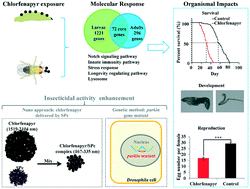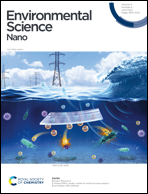Combination of a nanocarrier delivery system with genetic manipulation further improves pesticide efficiency: a case study with chlorfenapyr†
Abstract
Excessive usage of pesticides poses a great threat towards the global environment. Reducing pesticide usage by improving the insecticidal efficiency is essential for environmental protection. Delivery by nanocarriers has shown great potential in reducing pesticide usage, but whether its combination with other methods could further improve pesticide efficiency is not fully investigated. Here we report that the combination of nanocarrier delivery and genetic manipulation significantly improves the efficiency of a widely used pesticide chlorfenapyr. We analyzed the lethal and sublethal effects of chlorfenapyr using the model insect Drosophila melanogaster, the fruit fly. We found that the mixture of a star polycation (SPc) nanocarrier with chlorfenapyr reduces the particle size and enhances the insecticidal effect. We further showed that genetically removing the parkin gene renders flies more sensitive to chlorfenapyr. When delivered by SPc, a very low amount of chlorfenapyr which was totally tolerable by wildtype flies was sufficient to kill most of the parkin mutant flies. Our results demonstrate that the combination of these two methods generates synergetic effects and leads to a significant increase of chlorfenapyr efficiency. Given the rapid development of nanotechnology and functional genomics, our strategy could be applied for designing sustainable crop protection methods to reduce pesticide pollution.

- This article is part of the themed collections: Nano-bio interactions, Environmental Science: Nano Recent HOT Articles and Best Papers 2022 – Environmental Science: Nano


 Please wait while we load your content...
Please wait while we load your content...